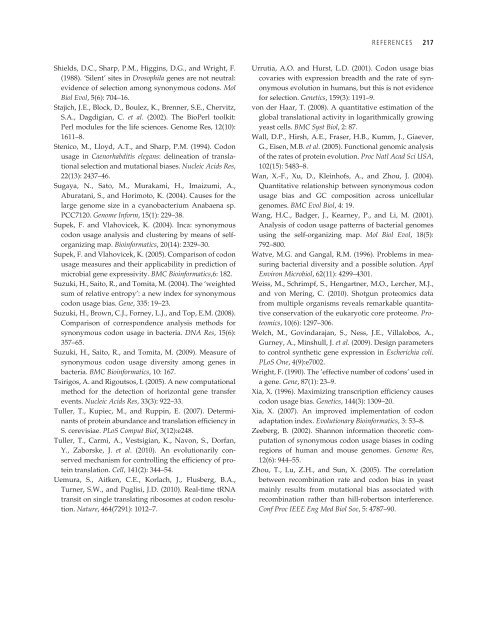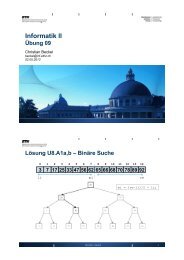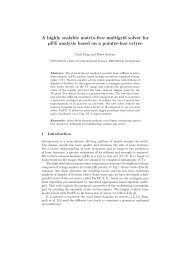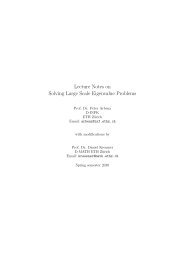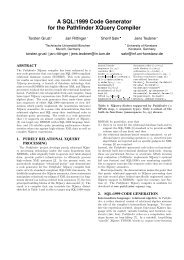Codon Evolution Mechanisms and Models
Codon Evolution Mechanisms and Models
Codon Evolution Mechanisms and Models
You also want an ePaper? Increase the reach of your titles
YUMPU automatically turns print PDFs into web optimized ePapers that Google loves.
Shields, D.C., Sharp, P.M., Higgins, D.G., <strong>and</strong> Wright, F.<br />
(1988). ‘Silent’ sites in Drosophila genes are not neutral:<br />
evidence of selection among synonymous codons. Mol<br />
Biol Evol, 5(6): 704–16.<br />
Stajich, J.E., Block, D., Boulez, K., Brenner, S.E., Chervitz,<br />
S.A., Dagdigian, C. et al. (2002). The BioPerl toolkit:<br />
Perl modules for the life sciences. Genome Res, 12(10):<br />
1611–8.<br />
Stenico, M., Lloyd, A.T., <strong>and</strong> Sharp, P.M. (1994). <strong>Codon</strong><br />
usage in Caenorhabditis elegans: delineation of translational<br />
selection <strong>and</strong> mutational biases. Nucleic Acids Res,<br />
22(13): 2437–46.<br />
Sugaya, N., Sato, M., Murakami, H., Imaizumi, A.,<br />
Aburatani, S., <strong>and</strong> Horimoto, K. (2004). Causes for the<br />
large genome size in a cyanobacterium Anabaena sp.<br />
PCC7120. Genome Inform, 15(1): 229–38.<br />
Supek, F. <strong>and</strong> Vlahovicek, K. (2004). Inca: synonymous<br />
codon usage analysis <strong>and</strong> clustering by means of selforganizing<br />
map. Bioinformatics, 20(14): 2329–30.<br />
Supek, F. <strong>and</strong> Vlahovicek, K. (2005). Comparison of codon<br />
usage measures <strong>and</strong> their applicability in prediction of<br />
microbial gene expressivity. BMC Bioinformatics,6: 182.<br />
Suzuki, H., Saito, R., <strong>and</strong> Tomita, M. (2004). The ‘weighted<br />
sum of relative entropy’: a new index for synonymous<br />
codon usage bias. Gene, 335: 19–23.<br />
Suzuki, H., Brown, C.J., Forney, L.J., <strong>and</strong> Top, E.M. (2008).<br />
Comparison of correspondence analysis methods for<br />
synonymous codon usage in bacteria. DNA Res, 15(6):<br />
357–65.<br />
Suzuki, H., Saito, R., <strong>and</strong> Tomita, M. (2009). Measure of<br />
synonymous codon usage diversity among genes in<br />
bacteria. BMC Bioinformatics, 10: 167.<br />
Tsirigos, A. <strong>and</strong> Rigoutsos, I. (2005). A new computational<br />
method for the detection of horizontal gene transfer<br />
events. Nucleic Acids Res, 33(3): 922–33.<br />
Tuller, T., Kupiec, M., <strong>and</strong> Ruppin, E. (2007). Determinants<br />
of protein abundance <strong>and</strong> translation efficiency in<br />
S. cerevisiae. PLoS Comput Biol, 3(12):e248.<br />
Tuller, T., Carmi, A., Vestsigian, K., Navon, S., Dorfan,<br />
Y., Zaborske, J. et al. (2010). An evolutionarily conserved<br />
mechanism for controlling the efficiency of protein<br />
translation. Cell, 141(2): 344–54.<br />
Uemura, S., Aitken, C.E., Korlach, J., Flusberg, B.A.,<br />
Turner, S.W., <strong>and</strong> Puglisi, J.D. (2010). Real-time tRNA<br />
transit on single translating ribosomes at codon resolution.<br />
Nature, 464(7291): 1012–7.<br />
REFERENCES 217<br />
Urrutia, A.O. <strong>and</strong> Hurst, L.D. (2001). <strong>Codon</strong> usage bias<br />
covaries with expression breadth <strong>and</strong> the rate of synonymous<br />
evolution in humans, but this is not evidence<br />
for selection. Genetics, 159(3): 1191–9.<br />
von der Haar, T. (2008). A quantitative estimation of the<br />
global translational activity in logarithmically growing<br />
yeast cells. BMC Syst Biol, 2: 87.<br />
Wall, D.P., Hirsh, A.E., Fraser, H.B., Kumm, J., Giaever,<br />
G., Eisen, M.B. et al. (2005). Functional genomic analysis<br />
of the rates of protein evolution. Proc Natl Acad Sci USA,<br />
102(15): 5483–8.<br />
Wan, X.-F., Xu, D., Kleinhofs, A., <strong>and</strong> Zhou, J. (2004).<br />
Quantitative relationship between synonymous codon<br />
usage bias <strong>and</strong> GC composition across unicellular<br />
genomes. BMC Evol Biol, 4: 19.<br />
Wang, H.C., Badger, J., Kearney, P., <strong>and</strong> Li, M. (2001).<br />
Analysis of codon usage patterns of bacterial genomes<br />
using the self-organizing map. Mol Biol Evol, 18(5):<br />
792–800.<br />
Watve, M.G. <strong>and</strong> Gangal, R.M. (1996). Problems in measuring<br />
bacterial diversity <strong>and</strong> a possible solution. Appl<br />
Environ Microbiol, 62(11): 4299–4301.<br />
Weiss, M., Schrimpf, S., Hengartner, M.O., Lercher, M.J.,<br />
<strong>and</strong> von Mering, C. (2010). Shotgun proteomics data<br />
from multiple organisms reveals remarkable quantitative<br />
conservation of the eukaryotic core proteome. Proteomics,<br />
10(6): 1297–306.<br />
Welch, M., Govindarajan, S., Ness, J.E., Villalobos, A.,<br />
Gurney, A., Minshull, J. et al. (2009). Design parameters<br />
to control synthetic gene expression in Escherichia coli.<br />
PLoS One, 4(9):e7002.<br />
Wright, F. (1990). The ’effective number of codons’ used in<br />
a gene. Gene, 87(1): 23–9.<br />
Xia, X. (1996). Maximizing transcription efficiency causes<br />
codon usage bias. Genetics, 144(3): 1309–20.<br />
Xia, X. (2007). An improved implementation of codon<br />
adaptation index. <strong>Evolution</strong>ary Bioinformatics, 3: 53–8.<br />
Zeeberg, B. (2002). Shannon information theoretic computation<br />
of synonymous codon usage biases in coding<br />
regions of human <strong>and</strong> mouse genomes. Genome Res,<br />
12(6): 944–55.<br />
Zhou, T., Lu, Z.H., <strong>and</strong> Sun, X. (2005). The correlation<br />
between recombination rate <strong>and</strong> codon bias in yeast<br />
mainly results from mutational bias associated with<br />
recombination rather than hill-robertson interference.<br />
Conf Proc IEEE Eng Med Biol Soc, 5: 4787–90.


